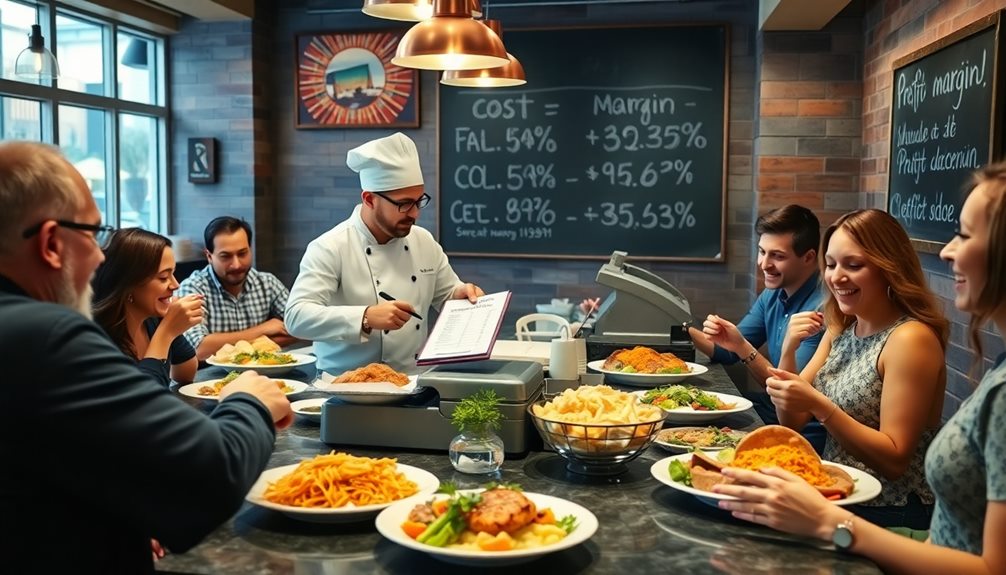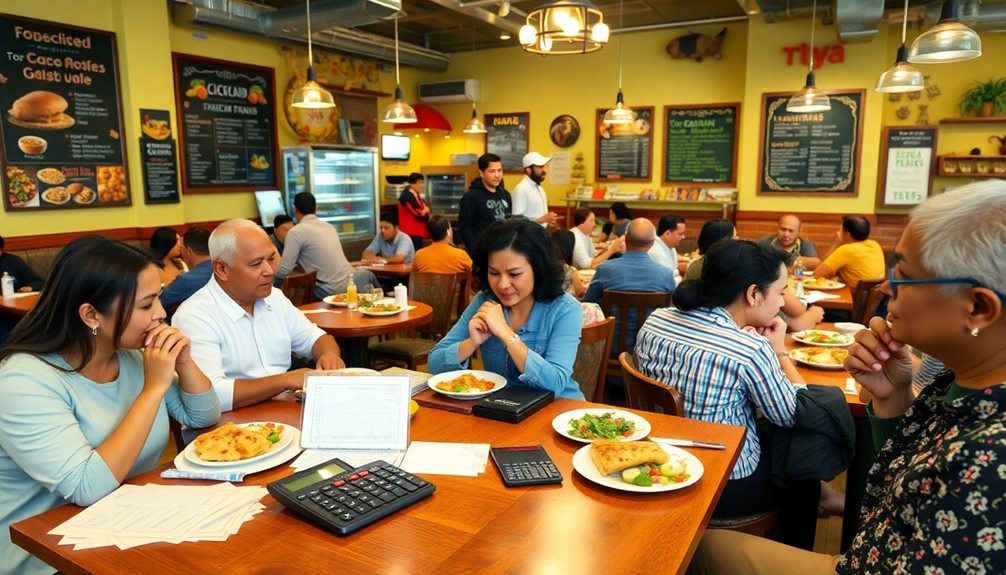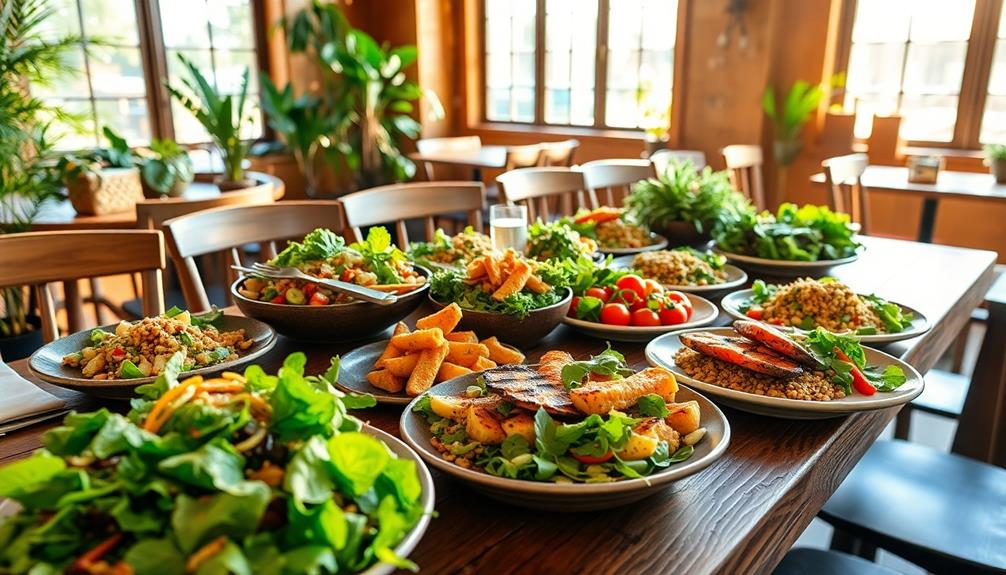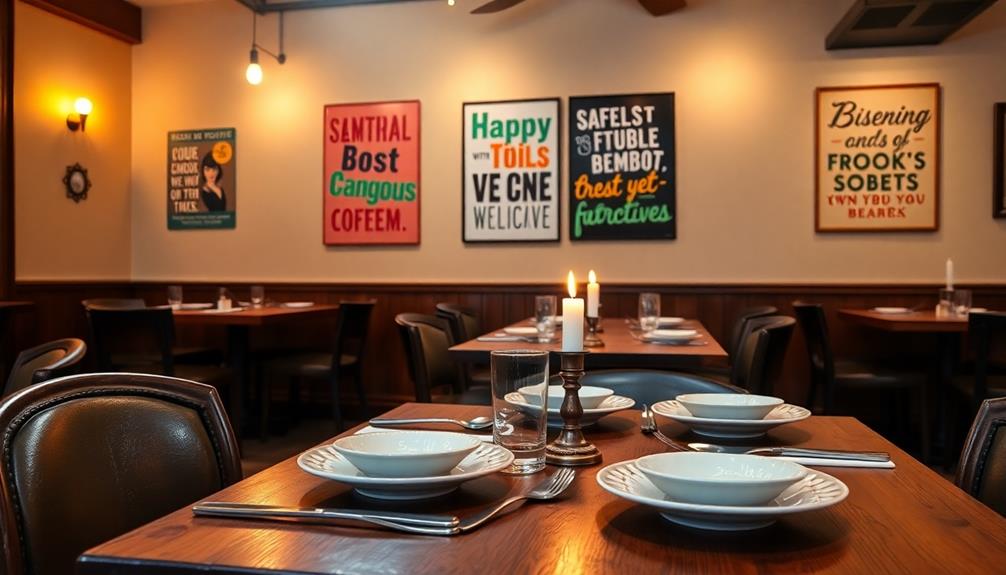To calculate restaurant profit margins, start by determining your gross profit margin. Use the formula: (Revenue – Cost of Goods Sold) / Revenue x 100. Aim for a gross margin of 70% or higher for effective cost management. Next, calculate your net profit margin, which includes all expenses: (Revenue – Total Expenses) / Revenue x 100. Typical net margins range from 3% to 10%. Regularly calculating and analyzing these margins helps you identify cost-saving opportunities and refine your pricing strategy. Stick around to uncover more insights on optimizing your restaurant's financial health.
Key Takeaways
- Calculate gross profit margin using the formula: [(Revenue – COGS) / Revenue] * 100, aiming for around 70% for optimal profitability.
- Determine net profit margin by subtracting all expenses from total revenue, then use: [(Revenue – All Costs) / Revenue] * 100.
- Average profit margins for full-service restaurants typically range from 3% to 5%, while quick-service venues can achieve 6% to 9%.
- Regularly analyze profit margins to identify trends, cost-saving opportunities, and refine pricing strategies for better financial health.
- Monitor food and labor costs, as they significantly impact profit margins, aiming for effective inventory and scheduling management.
Understanding Profit Margins
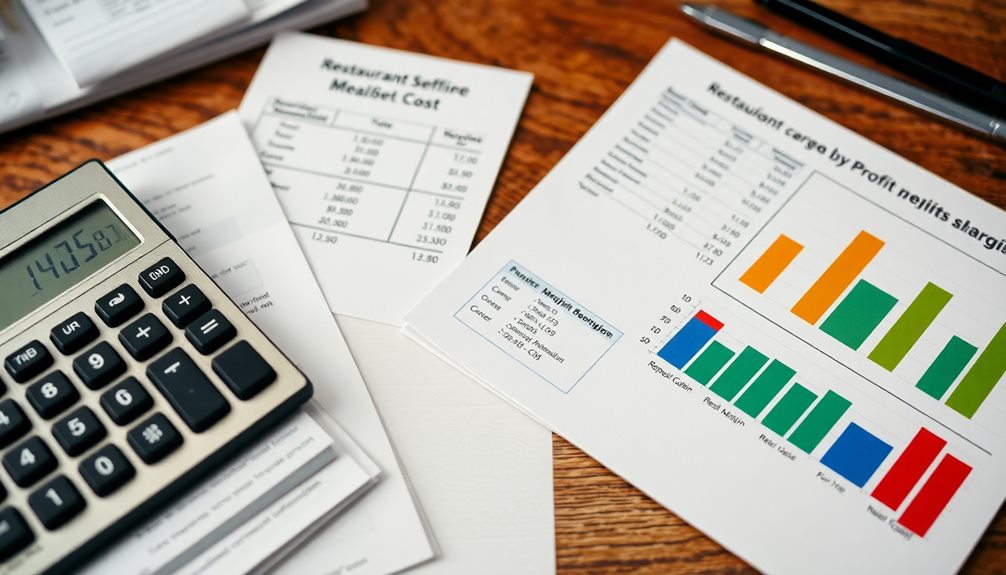
Understanding profit margins is fundamental for any restaurant owner who wants to keep a close eye on their financial health. Profit margins indicate the percentage by which your sales revenue exceeds total expenses, providing valuable insights into your restaurant's operational efficiency.
Two primary types of profit margins are essential for evaluating your business: gross profit margin and net profit margin.
The gross profit margin reflects profitability from sales after deducting the cost of goods sold (COGS). To calculate it, use the formula [(Revenue – COGS) / Revenue] ** 100. This margin helps you understand how well you're managing your food costs.
On the other hand, the net profit margin gives you a thorough view of profitability by including all expenses. You can calculate it using the formula [(Revenue – All Costs) / Revenue] **100.
Regularly monitoring both profit margins is critical. The average profit margin for restaurants typically ranges from 3% to 5%, with full-service restaurants averaging around 3-6%, while quick-service venues enjoy higher margins of 6-9%.
Types of Profit Margins

When it comes to understanding profit margins in your restaurant, you'll want to focus on two key types: gross profit margin and net profit margin.
Gross profit margin shows how well you're managing food and beverage costs, while net profit margin gives you a complete picture of your overall profitability after all expenses.
Knowing these differences can help you make smart decisions about pricing and cost control.
Gross Profit Margin Explained
Gross profit margin is an essential metric for restaurant owners, as it reveals how efficiently you're managing the costs associated with food and beverage production. Calculated using the formula \([(Revenue – Cost of Goods Sold) / Revenue] * 100\), this margin reflects the percentage of sales revenue that exceeds the direct costs associated with producing your offerings.
A healthy gross profit margin typically ranges from 70% to 80%, indicating strong operational efficiency. Understanding this margin helps you assess the profitability of individual menu items, allowing for informed pricing and inventory decisions.
Here's a quick overview of gross profit margin:
| Profit Margin Category | Percentage Range | Management Efficiency |
|---|---|---|
| Excellent | 80% and above | Very high |
| Good | 70% – 79% | High |
| Acceptable | 65% – 69% | Fair |
| Needs Improvement | Below 65% | Low |
Restaurants with a gross profit margin of 65% or higher are generally considered well-managed, effectively controlling their Cost of Goods Sold relative to their sales, thereby enhancing overall restaurant profit margins.
Net Profit Margin Overview
Net profit margin is a crucial indicator of your restaurant's overall financial health, capturing the percentage of revenue that remains after all expenses are deducted.
To calculate your net profit margin, subtract all costs—including food, labor, rent, utilities, and other operating expenses—from your total revenue. Then, use the formula: Net Profit Margin = [(Revenue – All Costs) / Revenue] * 100.
A typical net profit margin for restaurants ranges from 3% to 5%, but high-performing establishments can achieve margins of 10% or more.
This margin reflects how effectively you manage your overall expenses relative to your revenues, influencing both long-term sustainability and growth.
Importance of Profit Margins
Understanding profit margins is essential for any restaurant owner aiming to thrive in a competitive market.
Profit margins serve as critical indicators of your restaurant's financial health. They provide insights into how well you're managing costs and generating revenue.
The two main types of profit margins you should focus on are:
- Gross Profit Margin: This reflects your revenue minus the cost of goods sold (COGS), ideally around 70%. For every $100 in sales, aim for approximately $70 in gross profit.
- Net Profit Margin: This takes all expenses into account, including operating costs. Full-service restaurants typically see net profit margins between 3% to 5%, while quick-service establishments often enjoy higher margins of 6% to 9%.
Importance of Calculating Profit Margins
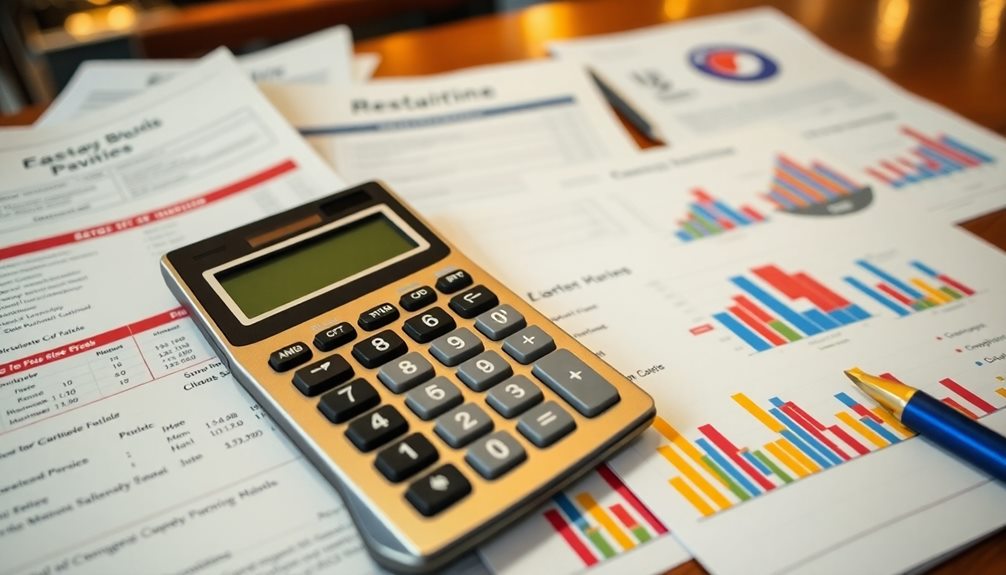
Calculating profit margins is essential for gauging your restaurant's financial health, helping you spot strengths and weaknesses in your operations.
It serves as a strategic decision-making tool, guiding you in making informed choices to boost profitability.
Plus, understanding these margins offers valuable insights into sustainability and growth, ensuring your business thrives in a competitive market.
Financial Health Indicator
Recognizing the significance of profit margins can provide a clear picture of your restaurant's financial health. These indicators reflect your ability to turn sales into actual profit after covering all expenses. The average restaurant profit margin typically ranges from 3% to 5%, while full-service establishments should aim for around 10% for sustainability and growth.
By regularly calculating your profit margins, you can gain valuable insights that help you:
- Identify areas for cost reduction
- Enhance revenue opportunities
- Better plan financially for the future
- Navigate economic downturns more effectively
Understanding both gross and net profit margins is essential. The gross profit margin focuses on revenue from food and beverages minus the cost of goods sold (COGS), while the net profit margin accounts for all operating expenses, giving you a more thorough view of profitability.
Improving your profit margins isn't just about squeezing costs; it's also about making informed decisions to invest in your restaurant's growth. By monitoring these metrics diligently, you'll be better positioned to maintain a competitive advantage in a high-stakes industry.
Strategic Decision-Making Tool
Profit margins serve as an important compass for restaurant owners steering through the complex landscape of the food industry. When you calculate profit margins, you gain valuable insights into your restaurant's financial health.
With average margins ranging from 2% to 6%, understanding this metric is vital for effective cost management. Knowing the difference between gross profit margin and net profit margin will help you make informed decisions. For instance, a strong gross profit margin of around 70% indicates that for every $100 spent by a customer, approximately $70 contributes to your gross profit.
Regularly monitoring these profit margins allows you to identify trends and areas for improvement. This proactive approach guarantees you stay competitive in a crowded market.
By utilizing profit margin calculations as a strategic decision-making tool, you can adjust menu prices and implement cost control measures, ultimately enhancing your overall profitability. Remember, each percentage point you improve your profit margin can greatly impact your bottom line, making it vital to stay vigilant and responsive to your financial metrics.
Embrace the power of profit margin calculations, and watch your restaurant thrive.
Sustainability and Growth Insights
Understanding your restaurant's profit margins isn't just about numbers; it's a pathway to sustainability and growth. By regularly calculating your profit margins, you gain vital insights into your restaurant's financial health. With average profit margins ranging from 3% to 5%, knowing where you stand can make all the difference.
Implementing effective cost-control measures, such as utilizing essential low carb foods, can also help enhance your profitability.
Consider these key points:
- Aim for higher profit margins of about 10% for full-service restaurants to boost reinvestment opportunities.
- Endeavor for gross profit margins around 70% to evaluate your food and beverage efficiency.
- Monitor trends in operating costs and revenues to identify areas for improvement.
- Use insights from profit margins to make informed decisions on pricing and menu offerings.
When you keep a close eye on these figures, you can implement strategies that enhance sustainability, such as reducing food waste and optimizing labor costs.
Ultimately, continuous assessment of profit margins empowers you to adapt and thrive in a competitive market, ensuring long-term success. Embracing this practice will position your restaurant not just to survive, but to grow and flourish.
Steps to Calculate Gross Profit
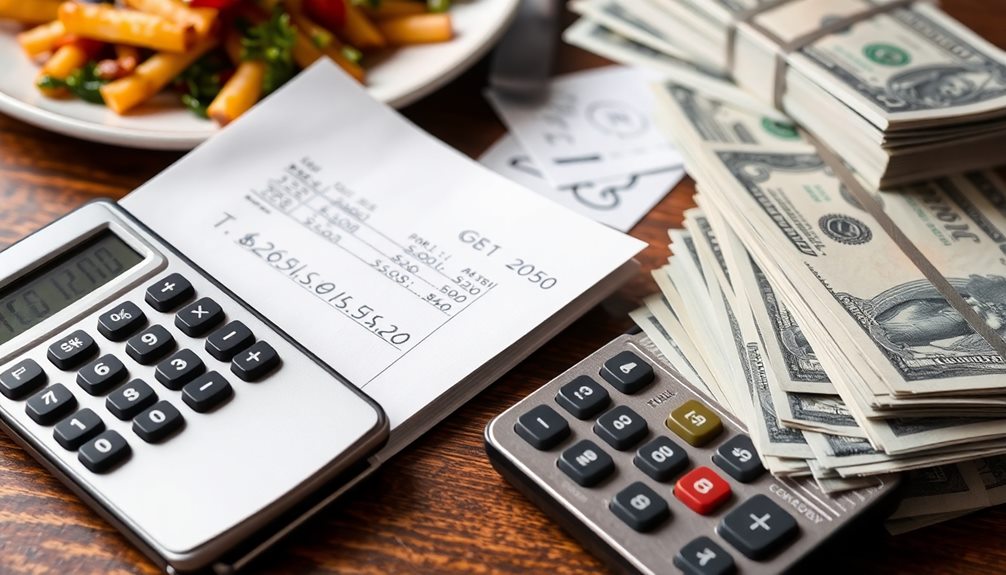
Calculating gross profit is essential for any restaurant owner looking to gauge their financial health. To determine your gross profit, start by subtracting your total cost of goods sold (COGS) from your total revenue generated from food and beverage sales. The formula is straightforward: Gross Profit = Total Revenue – COGS.
Remember, COGS includes all direct costs associated with preparing your menu items, such as ingredients and supplies.
For instance, if your restaurant generates $350,000 in revenue and has COGS of $205,000, your gross profit would be $145,000. This figure is vital as it reflects how efficiently you're managing your costs in relation to sales.
Once you've calculated your gross profit, you can assess your profit margin. To find your gross profit margin, divide your gross profit by your total revenue and multiply by 100 to express it as a percentage.
Following our earlier example, your gross profit margin would be about 41.4%. Aiming for a gross profit margin of around 70% is ideal, showcasing effective cost management and healthy profitability in your restaurant.
Steps to Calculate Net Profit
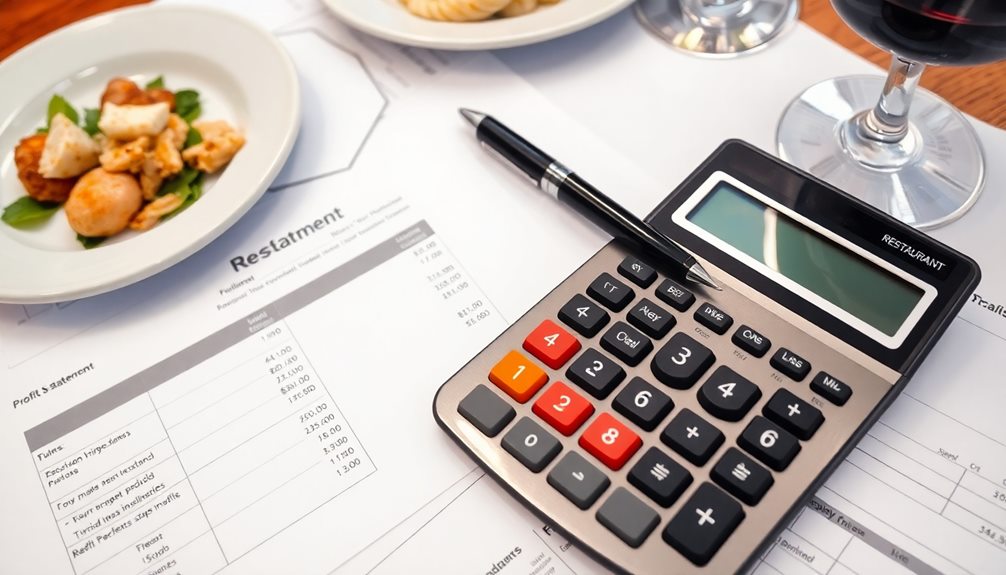
Determining your restaurant's net profit is vital for evaluating its overall financial performance. To get started, follow these straightforward steps:
- Calculate your total revenue from food and beverage sales.
- Identify and list all expenses, including cost of goods sold (COGS), labor, rent, and utilities.
- Use the formula: Net Profit = Total Revenue – Total Expenses.
Regularly track your net profit margins, which typically average around 3% to 5% for restaurants.
By subtracting your total expenses from your total revenue, you'll determine your net profit. This figure is essential for understanding how well your restaurant is doing financially.
It's important to keep a close eye on net profit over time. Monitoring changes can reveal trends in operational efficiency and highlight areas where you can cut costs or boost revenue.
Staying informed about your net profit not only helps maintain the financial health of your restaurant but also supports long-term sustainability.
Make this calculation a regular part of your financial review process to keep your restaurant thriving.
Analyzing Your Profit Margins
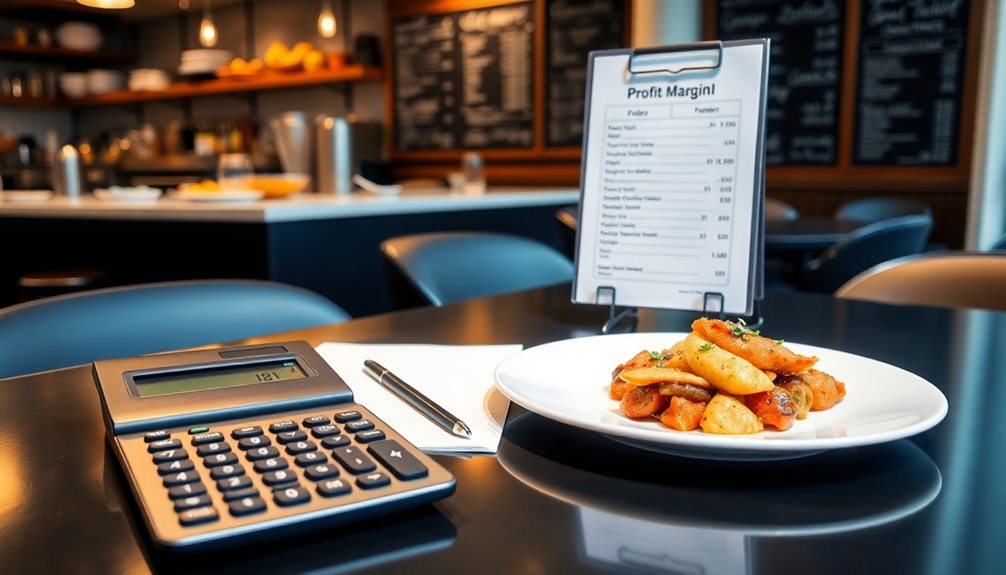
Once you've established your net profit, it's time to analyze your profit margins for a clearer picture of your restaurant's financial health. Start by calculating your gross profit margin. Subtract the cost of goods sold (COGS) from your total revenue, then divide by total revenue and multiply by 100 to get a percentage. Aiming for a gross profit margin around 70% is ideal, meaning for every $100 spent by a customer, about $70 is your gross profit.
Next, focus on the net profit margin, which considers all operating expenses. To calculate net profit margin, subtract total costs—including COGS, labor, rent, and utilities—from total revenue, then divide by total revenue and multiply by 100. For full-service restaurants, average profit margins typically range from 3% to 5%, while quick-service establishments can see margins between 6% and 9%.
Regularly analyzing your profit margins is essential. It helps you pinpoint cost-saving opportunities and refine pricing strategies, keeping you competitive and profitable in the ever-changing restaurant landscape.
Stay on top of these figures to guarantee your financial success.
Factors Affecting Profit Margins
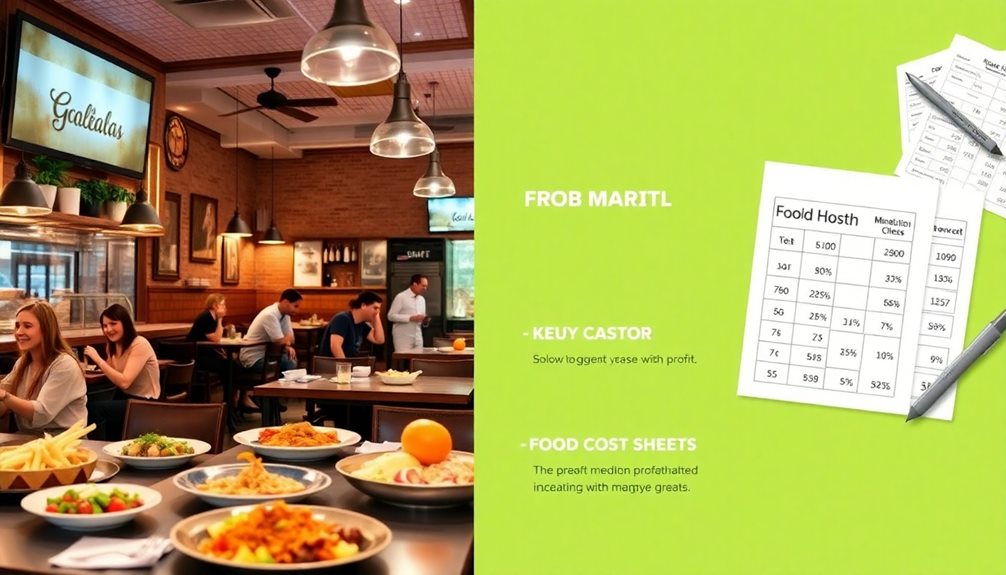
What factors truly shape your restaurant's profit margins? Understanding these elements is important for your bottom line. Your profit margins are primarily influenced by three major costs: Cost of Goods Sold (COGS), labor, and overhead. COGS typically takes up about one-third of your revenue, making effective inventory management and portion control essential to keep food costs in check.
Consider these key factors:
- Labor Costs: They often account for another third of your revenue. Smart scheduling and managing employee turnover can help maintain profitability.
- Overhead: Rent, utilities, and operational expenses consume the remainder of your income. Keeping these costs under control is necessary.
- Food Waste: With projections showing that food waste could cost restaurants $1.5 trillion by 2030, minimizing waste is significant for enhancing profit margins.
- Food Cost Percentage: Aim for a food cost percentage between 28% and 35%. If your costs are higher, it might be time to adjust prices or reassess your purchasing strategy.
Tools for Margin Calculation

To effectively manage your restaurant's profit margins, utilizing the right tools for margin calculation is essential. A profit margin calculator allows you as a restaurant owner to easily input total revenue and costs, calculating both gross and net profit margins to gain clear financial insights. Many free online calculators have user-friendly interfaces that simplify the process, making them accessible even for those without extensive accounting knowledge.
Incorporating integrated POS systems can further enhance your margin calculations by providing real-time sales data. This data can be used alongside margin calculators to monitor and adjust your profit margins effectively. Additionally, many calculators offer benchmarks against industry standards, which can help you compare your margins to averages specific to your restaurant type or region.
Here's a quick overview of some tools you might consider:
| Tool Type | Features | Best For |
|---|---|---|
| Profit Margin Calculator | Easy input of revenue and costs | Quick calculations |
| Online Calculators | User-friendly, often free | Small business owners |
| Integrated POS Systems | Real-time data and reporting | Thorough tracking |
Strategies to Improve Profit Margins
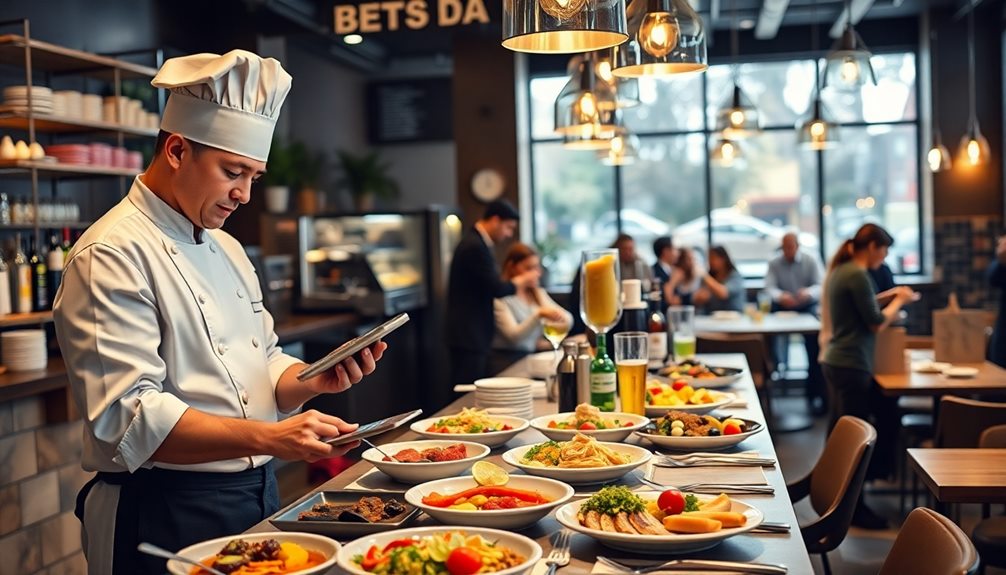
Improving your restaurant's profit margins requires a strategic approach that focuses on key areas of your operations. By implementing effective strategies, you can enhance your profit while keeping your customers satisfied.
- Aim for a food cost percentage between 28% and 35%. Regularly analyze dish costs and adjust menu prices to align with this target.
- Use menu engineering techniques to highlight high-margin items. This guides customers toward more profitable choices while maintaining a balanced menu.
- Train your staff in upselling techniques. When your team effectively encourages additional purchases, you can greatly increase average check sizes and overall revenue.
- Optimize labor costs by smart scheduling. Align staffing with peak demand times to reduce unnecessary overtime and improve payroll efficiency.
Frequently Asked Questions
How to Calculate the Restaurant Profit?
To calculate your restaurant's profit, subtract all costs, including food, labor, and overhead, from your total revenue. This'll give you a clearer picture of your financial health and areas needing improvement.
How Do You Calculate Profit Margin Formula?
When it comes to crunching numbers, you can calculate profit margin using the formula: (Revenue – Total Costs) / Revenue x 100. Keep your eyes on the prize for a clearer financial picture!
What Is the Formula for Calculating a Restaurant's Revenue?
To calculate a restaurant's revenue, sum all sales from food, beverages, and services over a period. You can use the formula: Total Revenue = Number of Customers x Average Check Size to determine your earnings.
How Do You Calculate P&L for a Restaurant?
Calculating P&L for a restaurant is like piecing together a financial puzzle. You start with total revenue, subtract COGS, then deduct operating expenses to find your net profit, giving you a clear financial picture.
Conclusion
So, there you have it! Calculating profit margins isn't rocket science—unless, of course, you're trying to split the bill at dinner. With just a few steps, you can uncover the secrets hiding in your spreadsheets. Remember, knowing your margins can save you from becoming the next viral "restaurant fail" on social media. So, roll up those sleeves, crunch those numbers, and let's turn that culinary chaos into cash! After all, who doesn't want to serve profit with a side of fries?
